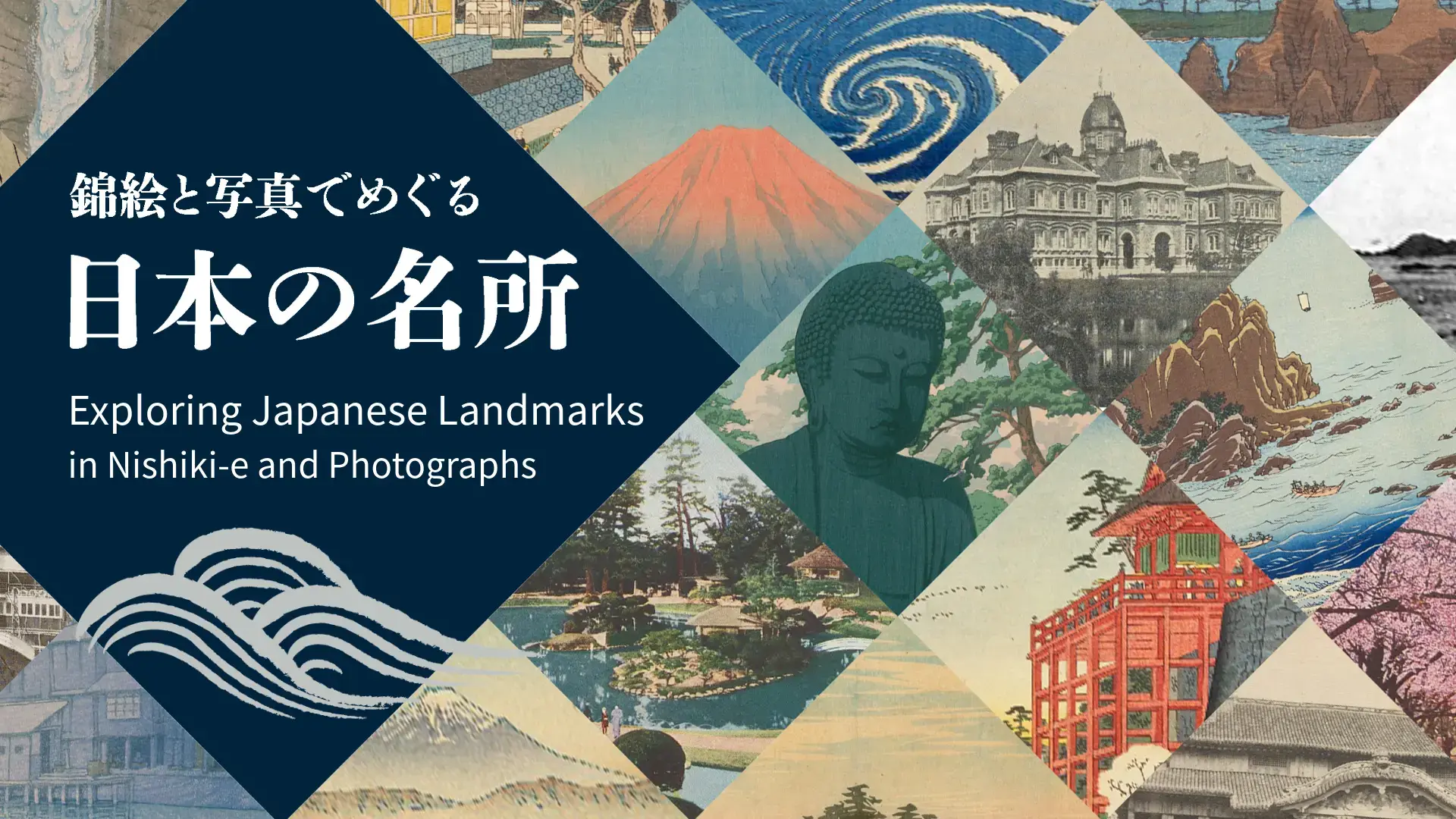
宝塚温泉
このコラムは、平成20年に電子展示会「写真の中の明治・大正(大阪編)」の中で公開したコラムを移行したものです。内容は当時の記載内容に基づきます。
ここに写っている温泉の風景は兵庫県川辺郡小浜村川面あたりから撮ったものと推測される。写真の中ほどちょっと低くなった木立のあたりを武庫川が流れ、写真右手の木立の手前あたりに宝来(蓬莱)橋があって、両岸を結んでいるはずである。橋脚一本で橋桁を支えためずらしい構造の橋で洪水によりしばしば流失した。温泉旅館はその向こう岸(右岸)に建っている。手前の白く一直線に走るのは阪鶴鉄道(はんかくてつどう)(明治40(1907)年から国鉄、現JR福知山線)であろう。左手前で単線が複線になっているように見えることから右手の方が宝塚駅である。右岸は相当の市街地を形成しているのに、こちら側(左岸)はまだ一面の原っぱ、のどかな田園風景である。この原っぱに市街が形成され始めるのは明治末年から大正にかけて、電鉄会社による新温泉の開発がはじまってからである。
近隣の村民が汲み取って浴用にしていた温泉を近代的温泉として、武庫川の右岸(武庫郡伊孑志(いそし)村)に開業したのは明治20(1887)年である。このとき縁起の良い名前として「宝塚温泉」と命名された。開業当時の旅館は4軒であった。
「宝塚」というのはもともと川辺郡米谷村にあった塚の名前である。
「宝塚 同郡米谷村にあり。此塚の許に於いて、物を拾う者、必ず幸あり。是を以って、宝塚と号るの所伝たり」と元禄頃の地誌『摂陽群談』は伝える。宝塚の市名や温泉の名はこれに基づく命名である。
宝塚温泉の開発は何と言っても二つの鉄道と少女歌劇(後の宝塚歌劇)に負うところが大きい。また小林一三の存在も忘れることはできない。
小林一三は山梨県韮崎の商人の家に生まれた。慶応大学卒業後、三井銀行を経て阪鶴鉄道の監査役、箕面電車創立の発起人、専務取締役に就任して鉄道事業に参画していく。後に阪急社長、会長に就任する一方では宝塚歌劇団を創立、音楽学校長に就任し歌劇団の発展につくすと同時に、戦後東宝社長に就任するなど、鉄道事業、娯楽事業、不動産業を結びつけ、わが国の経済界に大きな足跡を残した。
二つの鉄道と沿線の開発
二つの鉄道とは阪鶴鉄道と箕面有馬電気軌道(大正7(1918)年から阪神急行電鉄)である。
明治30(1897)年に阪鶴鉄道が開通する。これが契機となり、40年代にかけて「武庫郡有数の市街」(『宝塚温泉案内』)を形成するようになった。43(1910)年、箕面有馬電気軌道(以後、箕面電車と略称)(現在阪急宝塚線)が開通する。これによって新温泉の開発が始まり一面の原っぱであった武庫川左岸に市街地が形成されるようになる。さらに大正10(1921)年には阪急西宝線(現:今津線)が開通し、宝塚南口駅が右岸にできる。梅田や西宮からのアクセスが便利になる。
箕面電車が発行する『梅田より神戸箕面宝塚へ』(大正10年刊)には、武庫川右岸の延命山から撮った写真が掲載されていて、左岸に建物が立ち並び市街地が形成されつつある大正時の様子を伺うことができる。
箕面電車は当初一両編成で、畠や田んぼの中を走り回る遊覧電車という意味で「みみず電車」と悪口を言われたり、旧温泉の有力者との話し合いがつかず、左岸の埋立地を買収して新温泉を開発せざるをえないなど、開発事業は容易ではなかった。しかし箕面電車は鉄道事業と温泉と宅地開発で成功していく。現在の池田市にニュータウンを造成し、わが国ではじめてローン方式を取り入れて中流サラリーマン向けに売り出した。
箕面電車の終点が新温泉である。大理石づくりの豪華な大浴場や音楽室などの娯楽施設をもち「パラダイス」と呼ばれた家族向けの温泉である。『すみれ花歳月を重ねて:宝塚歌劇90年史』にこの写真とほぼ同じ位置から撮影し、左岸に新温泉、「パラダイス」が建っている写真が掲載されている。閑静な原っぱに建てられた当時の様子が見て取れる。新旧温泉は「モダン気分、大衆気分、日帰り気分」の新温泉と「入湯気分、遊蕩気分、逗留気分」の旧温泉(「宝塚新繁昌記」『近畿景観 〔第1編〕 摂津大和』)と、うまく住み分けができていたようである。
箕面電車は集客対策として婦人博覧会、婚礼博覧会などを開催したが、魅力が少ない。そこで考えられたのが、少女歌劇、後の宝塚歌劇団である。大阪三越デパートにあった少年音楽隊にヒントを得て少女歌劇が作られた。少女歌劇は、大正2(1913)年に第1期、2期生として12歳から19歳の少女20人が採用され、宝塚唱歌隊として発足し、3(1914)年4月1日から5月30日まで第1回公演を行ったのが始まりである。
昭和15(1940)年10月に宝塚歌劇団と改称、戦時中の大劇場の軍による接収・閉鎖、戦後の再開などを経て、同劇団の60周年の(1974)年に初演した「ベルサイユのばら」と3年後の「風と共に去りぬ」が空前のブームを引き起こす。宝塚温泉も同時期に最盛期を迎える。45(1970)年、大阪万国博覧会の観光客が足を運び約133万人が宿泊した。
大震災、そして現在
しかしこのように発展してきた宝塚温泉であったが、その後の歩みは平坦ではない。平成7(1995)年1月17日に発生した阪神・淡路大震災は、甚大な被害をもたらした。阪急宝塚駅近くなどでは震度7を記録。市内全域で全半壊家屋は約13,000棟、118人もの尊い命が犠牲になった。震災による関西圏全体の不況や娯楽嗜好の変化により、ファミリーランド―最盛時には年間4,000,000人の入場者を数えた―の閉園、旅館ホテル、入湯者数の減少も続いている。市は復興プロジェクトを順次進めながら、新温泉泉源の掘削、新観光ダム、新観光噴水、市立宝塚温泉の建設などを行い、安全・快適でこれまで以上に魅力ある街づくりを目指している。
引用・参考文献
- 宝塚市史編集専門委員編『宝塚市史.第3巻』宝塚市,1977 【GC172-52】
- 岡田徯志『摂陽群談』歴史図書社,1969 2冊 (底本は大日本地誌大系(大正5年刊)所収本 ) 【GC161-4】
- 平池一三・山下芳雄編『写真集明治大正昭和宝塚:ふるさとの想い出185』国書刊行会,1981 【GC172-102】
- 加藤紫芳編『宝塚温泉案内』矢島誠進堂,明治36(1903) 【67-268】
- 阪神急行電鉄株式会社編『梅田より神戸箕面宝塚へ』阪神急行電鉄,大正10(1921) 【11-491】
- 津金沢聡広『宝塚戦略:小林一三の生活文化論』(講談社現代新書)講談社,1991 【KD597-E14】
- 『宝塚歌劇五十年史』宝塚歌劇団,1964 2冊(別冊共) 【766.7-Ta377t3】
- 『すみれ花歳月を重ねて:宝塚歌劇90年史』宝塚歌劇団,2004 【KD597-H13】
- 宝塚市編『阪神・淡路大震災:宝塚市の記録1995』宝塚市,1997 【AZ-1553-G11】








